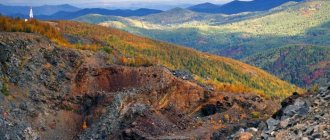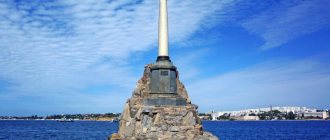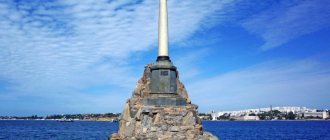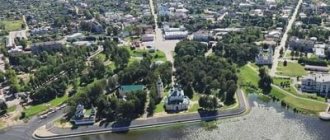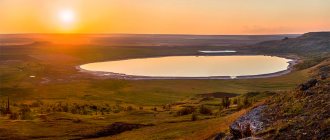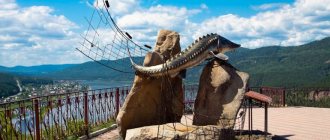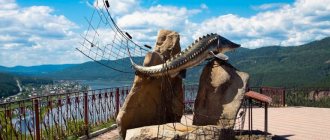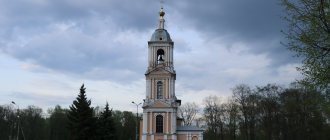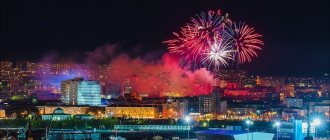Perm is one of the largest, most developed and beautiful cities in the Kama region, the administrative center of the Perm region. It was formed in the first half of the 16th century. on the site of the village of Bryukhanovo, where the Yagoshinsky copper smelter was built in 1723. The day the plant was founded became the city’s birthday, and Perm received its modern name and city status in 1780 by Decree of Catherine the Great.
The city grew from a workers' village and today is considered the scientific, cultural and industrial center of Russia. Its favorable location on trade routes, active shipping and shipbuilding, and large-scale salt and fur mining significantly contributed to the development of the city. From 1940 to 1957 Perm was called Molotov.
Komsomolsky Prospekt
Komsomolsky Prospekt in Perm is considered one of the most beautiful places in the city, where many architectural attractions and monuments are concentrated: the Cathedral of the Spaso-Preobrazhensky Monastery and the bishop's house (1793-1832), now it houses a local history museum and art gallery, the Permyak monument – salty ears”, etc.
Evolution of Perm. Two centuries of the city center. Part 1
“Downtown,” that is, literally “lower city,” is usually called the administrative and business center, but in the case of Perm, the center rather personifies the “upper city,” because a significant and ancient part of it is located on Mount Sludka, towering above the rest of the central region - where sometimes less, sometimes more.
| Perm city plan 1823 |
On the other hand, if you ask the average person what place should be considered the central point of the city, he will name the esplanade, which is precisely located in the lowland.
| Krasnoufimskaya (Kuibysheva) streets at the beginning of the 19th century |
The debate about whether the founding of the Yegoshikha plant can be considered the founding date of Perm, or whether the report should start with the establishment of the Perm governorship in 1781, has long been resolved at the official level. But it is worth recalling this: otherwise it is difficult to explain the beginning of the story about the city not from 1723, but only from the end of the 18th century.
| Lenin Street (Pokrovskaya) |
One of the most popular urban historical sayings says that thanks to Karl Moderakh , the commander of the Perm province in 1796–1811, “Perm was built more correctly than New York.”
accidentally thrown by the writer Pavel Melnikov-Pechersky and distorted by the chronicler of Perm Vladimir Verkholantsev actually reflects the transition of Russian urban planning from chaotic development to pre-developed plans, which took place just at the moment when it came to the development of the newly founded provincial city.
| Komsomolsky Avenue. View from Monastyrskaya street towards st. Soviet |
Talking about the evolution of the microdistrict, conventionally designated on administrative maps as “Center-1,” is not so easy. Firstly, unlike many outlying microdistricts, the logic of identifying the boundaries of this territory was not dictated by its historical development: the old center, for that matter, shifted more towards Sibirskaya Street, and not towards Popova Street, which cuts the center in half. Secondly, the number of historical buildings, both demolished and reconstructed, is so large that there is a risk of diving too deeply into the details. But you still have to be patient.
| Kuibysheva Street before 1950 |
The central microdistrict occupies the area from the southern bank of the Kama in the north to Kolkhoznaya Square and the odd side of Pushkin Street in the south. The western border is the even side of Krysanova Street, the eastern border is the odd side of 25th October Street.
| The building of the Alexander Hospital (now the Regional Clinical Hospital) on the street. Pushkin was built in 1833. Today it is located on the southern border of the central region of Perm |
| The building of the city almshouse on the street. Pushkina, 83. Today - the Church of Simeon of Verkhoturye |
This slightly curved quadrangle houses the main government and administrative buildings, several universities, theaters and squares, ancient mansions and modern business centers - the “Brussellization” of the city is especially striking here.
| Komsomolsky Avenue. View from the street Sovetskaya towards the street. Monastyrskaya |
It is no secret that the initial development of Perm went down the Kama towards a relief convenient for development. At the same time, the city grew in depth, but not too much, since the only economic artery before the opening of the Perm railway station in 1899 was the river. It is not surprising that the expansion of the city along the coast occurred faster than the deepening towards the Kazan Highway.
| Completion of the City Council building (now the Perm administration and the Perm City Duma), 1931 |
Since the center of today's Perm is strongly associated with the esplanade, let's start with it. It’s hard to believe that the vast space from the House of Soviets to the Theater is a relatively recent architectural “invention.” The demolition of old wooden houses in this essentially outlying part of the city began in the mid-20th century.
| Lenin Street. Construction of the House of Soviets |
| Center of Perm, 1990 |
In the 1960s–1970s, housing development was planned here, but, as legend has it, Anatoly Soldatov, by his decision, canceled these plans, on the one hand, creating the main Perm attraction of our time, on the other, giving rise to disputes about the purpose of this territory, which have flared up over the past two years with renewed vigor.
| View of residential buildings along Petropavlovskaya (Kommunisticheskaya) street, 1989 |
The main objects and architectural dominants of the modern esplanade - the House of Soviets and the Drama Theater - were commissioned in 1973 and 1981, respectively.
| Construction site of the Drama Theater, 1976 |
Another point of attraction of the central microdistrict, despite the loss of its significance as a large shopping center in recent years, is still the central department store and the square in front of the Ural Hotel - a kind of mini-esplanade.
| The largest Central Department Store in the Urals at that time opened on December 29, 1965. In the photo - 1967 |
| The Ural Hotel was built in 1983 on the site of two-story houses. The eight-story building became the first stage of the hotel, which in subsequent years was built along Lenin Street |
Before the appearance of an esplanade on the plan of Perm, a city square similar in purpose, where rallies and festive demonstrations were held, was Okulov Square, which in 1977 became the Square of the Ural Volunteers and changed beyond recognition.
| Okulov Square in festive decoration, 1930s |
| Square of Ural Volunteers |
The buildings of the former tobacco factory and printing house No. 2 located next to the square are among the most remarkable in the area, and the fact that they were preserved during the construction of the residential complex is a great success. This part of the city is still associated with the black market, which was the center of trade in Perm before the revolution.
| The building of the former printing house No. 2 |
Another pre-revolutionary building in the neighborhood that has survived to this day is the trading house of the merchant Dmitry Izhboldin on the corner of Osinskaya and Petropavlovskaya streets. In 1916, Boris Pasternak , and during the Civil War, the troops of Alexander Kolchak . During the Soviet period, the building changed its purpose several times, until in 1991 it became the Rostock Center for Artistic Creativity.
| House of Dmitry Izhboldin |
Of the notable pre-revolutionary buildings in the area, one can note the now dilapidated house of the merchant Mikhail Kamchatov , bulging with its bulk at the intersection of Kuibyshev and Monastyrskaya.
| Apartment building of Mikhail Kamchatov |
At the next intersection, if you move towards Perm-I, you will notice the repeatedly rebuilt building of the Perm Theological Seminary, which graduated many notable personalities. In 1891, a water supply was installed near the seminary building, although Kama water was already considered dirty, especially during flood periods.
| View of the Perm Theological Seminary (left) and the Transfiguration Cathedral |
Here, on Mount Sludka, stands one of the most replicated symbols of Perm - the Transfiguration Cathedral. In 1781, together with the decree on the creation of the Perm governorship, it was decided to move the Pyskorsky monastery to Perm. The move was delayed, and the first monastery building on Sludskaya Mountain was founded in 1793.
| Komsomolsky Avenue. View of the Transfiguration Cathedral |
The cathedral building was erected in 1798-1832 by a whole group of architects, and the Bishop's House - in 1793-1800. In 1922, an art museum was opened in the building of the former "bishop's chambers", and in 1931 the building of the former cathedral was transferred to house an art gallery.
| Square in front of the Transfiguration Cathedral, mid-20th century |
If Cathedral Square, at least due to its small size, has practically not changed its appearance over the past 70 years, then another square located in this microdistrict - Oktyabrskaya - has changed dramatically.
| Sennaya Square |
The decision to move the market from here to the area of the intersection of Pushkin Street and Kazansky Trakt (Cosmonaut Highway) was made by the Molotov Executive Committee in 1946. The square received its current revolutionary name in 1964. As for the collective farm market, also part of the Center microdistrict, it was put into operation in the fall of 1956 and received the sixth of seven possible categories in the USSR.
| View of the square in front of the central market, 1990. Photographer Yu. Kondakov. |
During the construction of the main building of the Perm Polytechnic Institute in the 1950s and the building of the Perm Institute "Promstroyproekt" in the 1960s, old houses and the Trinity Church were demolished on the former Sennaya Square, which we briefly mentioned in the material about the PNIPU complex.
| Corner of Lunacharsky Street and Komsomolsky Prospekt |
| Polytechnic Institute building, 1964 |
We move along Lunacharsky Street towards Sibirskaya. Here, from the point of view of territory development, the oblong building of the Palace of Youth Creativity, built in the mid-1980s, is of interest.
| Construction of the Palace of Youth Creativity, 1980s |
The palace is one of the few relatively modern buildings that managed to fit into the pre-revolutionary buildings of Perm that remained almost unchanged. The problem with the lack of space was initially solved much more humanely. For example, with virtually no damage to their appearance, floors were added to two iconic buildings located at the intersection of Sibirskaya and Lenin streets. Olga Petrovskaya’s bookstore was located before the revolution , and about the building of the administration of Perm (Perm State Chamber), which later almost painlessly grew two floors each.
| Corner of Sibirskaya and Pokrovskaya (Lenin) streets. Olga Petrovskaya's bookstore |
| The building of the Perm State Chamber, postcard from the early 19th century |
If Sibirskaya for most of the history of Perm was the central street of the city, along which “governors decided to drive quickly and only surrounded by mounted police,” then the central point of the city could be considered the square formed by the square of Lenin - Sibirskaya - Petropavlovskaya - October 25 streets. The old Gostiny Dvor, which “framed” the Theater Garden, was demolished in the late 1920s. The square that arose in its place was named after Komsomol.
| View of Komsomolsky Square, 1950 |
| The construction of the stone theater in Perm was completed in 1878. In 1957–1959 the building was completely reconstructed |
Moving again towards Komsomolsky Prospekt, let’s briefly look at two more objects, each of which experienced several periods of rise and decline. The history of the Church of the Nativity of the Virgin Mary began in 1789, when a one-story Vladimir Church was erected on Pokrovskaya Street, soon renamed. In 1816, construction of the main aisle on the upper floor was completed.
| The Church of the Nativity of the Virgin Mary was closed in 1928. Later, the building's dome and bell tower were destroyed. The restoration of the church was completed only in 2021 |
The building at 44 Lenina Street is a mansion that once belonged to Vera Zhuravleva . In 1913, the grand opening of the city’s first specialized cinema building, “Khudozhestvenny” (“Triumph”), took place here. Currently, the ancient building houses a private philharmonic society.
| The building of the cinema "Khudozhestvenny" ("Triumph") |
Less known to the modern generation of Perm residents, but no less interesting, was another cinema that operated in the city center. This is the Kolibri electrotheatre, opened in 1915, which was renamed Komsomolets in Soviet times (39 Petropavlovskaya St.).
| Cinema "Komsomolets" on the street. Kommunisticheskaya (Petropavlovskaya), 39 |
One of the most famous buildings on the same street is the Smyshlyaev house (Petropavlovskaya, 25), where once, before the construction of the building on Lenin Street, there was a library named after. Gorky.
| Smyshlyaev House |
The building, built at the end of the 18th century and restored after a terrible fire in 1842, is considered the prototype of the Yuryatinsk city library in the novel Doctor Zhivago. Today, there are not one, but two libraries at once - “Pushkinka” and the children's library named after Lev Kuzmin .
| Kommunisticheskaya Street (Petropavlovskaya). Filming date not set |
By the way, it was the fires of 1842, 1859 and 1879 that most contributed to the development of Perm in the 19th century, as they accelerated stone construction in the city.
| Chapel of Stefan Velikopermsky on the corner of Komsomolsky Prospekt and Petropavlovskaya Street. Soviet years |
Another street that has preserved many examples of ancient architecture to this day is Permskaya. At the Sibirskaya-Permskaya intersection, what attracts attention, despite its semi-disrepair condition, is the building of a clinic built in 1909, where until recently many residents of the Leninsky district went.
| Clinic building on Kirova Street (Permskaya), 1988 |
At the corner with Gazeta Zvezda Street, just on the border of the automobile and pedestrian zone, the gaze falls on the former building of the parochial school, built in 1896 at the expense of the parishioners of the Nativity of the Virgin Church according to the design of the architect Alexander Turchevich . Unfortunately, today an adequate perception of this architectural monument is hampered by the office center building sticking out from behind it (popularly known simply as “Vitus”). By the way, the purpose of the building has hardly changed - today it houses an Orthodox gymnasium.
| The building of the parish school of the Nativity of the Virgin Mary, 1985 |
The administration of the Leninsky district now lives in the building next to the school. But actually, the house on Permskaya, 57 is the former mansion of the merchant Pavel Zhirnov , built according to the design of the architect Vasily Popatenko in 1883–1885. During the years of Soviet power, the NKVD prison was first located here, then the executive committee of the Leninsky District Council.
| The former mansion of Pavel Zhirnov on Permskaya street, 57 |
Further on, on the same side of the street, a wooden mansion catches your eye - the house of the Tokarevs, built in a pseudo-Russian style. The building was built at the turn of the 19th and 20th centuries and was restored in the 1980s. As in the case of the parochial school, the proximity to a modern business hardly does this old mansion any favors.
| Former Tokarev mansion, 1985 |
In the second part of the story about the evolution of the center of Perm, we will focus on the territory a little more distant from the historical center and lying on the left side of Popova Street.
Materials provided by the State Archive of the Perm Territory
Alexander Glushkov for Properm.ru
Ascension-Feodosievskaya Church
The Ascension-Feodosievskaya Church (1903-1904) is the main cathedral of the city, one of the last pre-revolutionary ones in Perm. Initially, it bore the name of the Ascension of the Lord or Ascension. During the history of its existence, this place changed its purpose several times - a church, a hostel, a bakery. At the end of the 1970s. The bakery was removed by the authorities, and restoration of the beautiful facades began with the aim of placing an organ hall in this place. Since 1991, the building was returned to the Perm Diocese and major renovations were carried out using donations.
Tickle your nerves...
Thrill-seekers should definitely visit the Perm Tower of Death. At first glance, an ordinary building is shrouded in terrifying legends. According to legend, ghosts live here. Permians believe that the bodies of builders are walled up in the Tower, and that the cursed building is responsible for many innocent deaths.
People are sure that once there was a Stalinist prison here, where prisoners were shot. The underground passage led straight to the cemetery...
In fact, all these rumors have little to do with the real history of this popular place, but there is still something sinister in its history.
Sculpture “Permyak – salty ears”
The sculpture “Permyak – Salty Ears” is one of the most original in Russia, one of the symbols of Perm. It consists of two parts - an oval frame with protruding ears, into which you can insert your face, and a photographer with an old camera, ready to take pictures.
The composition received this original name from the ancient nickname of the city residents, who have long been involved in salt fishing. Their occupational disease - constantly swollen and red ears - arose due to the constant exposure of them to salt from the bags. The sculpture was opened in 2006, and since then it has become a popular place for photographing residents and guests of Perm.
Where else can you go with children?
Holidays in "October"
Children's entertainment offers several options for how to have fun and interesting time.
“Theater Trouble” is a day camp for children from 7 to 12 years old, where they have the opportunity to learn the behind-the-scenes life of the theater. Every day, under the guidance of experienced teachers, children will learn a new theatrical profession: artist, actor, director, make-up artist, choreographer.
Students will learn stage combat, choreography, stage speech and acting. They will learn how to create theatrical puppets, apply makeup, make scenery and stage plays.
The camp is designed for 5 days, it will run from March 25 to 29, from 8 a.m. to 7 p.m.
“Coolest of all in October” - summing up the results of the show competition for talented guys, dedicated to the birthday of “October”. Performances by the best of the best will take place on the stage of “October” from March 25 to 31.
October’s birthday is March 31, throughout the day many surprises await the center’s guests: a gift draw, a dance flash mob, a soap show, a paper disco, a drawing competition, a magic show and much more.
- All details can be found on the website - https://october.perm.ru
- Entertaining, Komsomolsky Prospekt, 46
- Open daily from 10 a.m. to 9 p.m. (Mondays from 2 p.m.)
New program at the circus
Don't miss the new program at the Perm circus - with the participation of artists from the Nikulin Circus and the Kenya Circus.
Spectators can expect magnificent stunts, a colorful Jamaican show ballet, Canadian bears, Nile crocodiles, Australian ostriches, giant Egyptian camels and other exotic animals.
And also - many bright and cheerful moments, modern technical lighting, laser and sound design and a spectacular show.
- Perm Circus, Uralskaya street, 112
- March 23, 24, 30 and 31, shows start at 12.00, 16.00
- Tickets: 600 – 1500 rubles.
The story of one magic
The puppet theater is premiering a new play. “Little Tsakhes, nicknamed Zinnober” is a fairy-tale grotesque story by Ernest Hoffmann.
Out of pity, the good fairy bewitches baby Tsakhes, who is ugly in body and soul, so much so that everyone around him stops noticing his ugliness. Now people are drawn to him. Any praiseworthy deed done in his presence is attributed to him, Tsakhes. And vice versa, as soon as he does something disgusting or shameful, in the eyes of those present, someone else seems to have done the abomination and, most often, the one who suffered the most from this trick.
And only one person - the poet Balthazar - sees everything that happens in its true light. Our melancholic hero will have to enlist the support of friends, confront the evil freak and tear off his hypocritical mask in order to show people the true face of an unworthy person.
- Puppet theater, Sibirskaya street, 65
- March 23 at 13.30
- Tickets: 250 – 500 rubles.
Science Amusement Park
This interactive and entertaining science museum will be of interest to children of all ages. Here are exhibits with which schoolchildren can learn the laws of physics and chemistry, mathematics and geometry in a playful way.
- Vosstaniya Street, 35
- Every day from 10 to 20 hours.
Skating in "Orlyonok"
Every Sunday at the Orlenok Sports Palace there are open training sessions on the indoor skating rink. Before visiting, you must register by calling 215-52-59.
Rides take place from 16.00 to 18.45. During this time, three sessions take place, each lasting 45 minutes. Skate rental and sharpening is also available.
- Sports Palace "Orlyonok", Sibirskaya street, 47
- March 24 and 31, from 16.00 to 18.45
- Tickets: 200 – 300 rubles.
Steam train ride
Perm residents are invited to take a ride along the tourist route on a steam locomotive. It runs from Perm II station to Levshino and back.
- Travel time is about two hours.
- March 23 and 30 at 10.00
- Tickets: 1160 rubles.
- Feed the tiger cub and walk the reindeer
Throughout March, the Perm Zoo hosts demonstration feedings of tiger cubs (starting at 15.00) and walks with reindeer (at 14.00) every Friday, Saturday and Sunday.
Perm Zoo
And on Saturday and Sunday, from 12 to 15 hours, there will be a petting zoo in the exotic animals pavilion. You can see the "Magic Chest" with bird feathers, antlers, bear fur, porcupine quills and much more. Everything can be touched and photographed. You can chat with Nicole the pig from 2 to 3 p.m.
- Perm Zoo, Monastyrskaya street, 10
- Every day from 10 to 18 hours, tickets: 150 - 250 rubles, children under 4 years old - free.
Bringing Down the House
An upside down house is an attraction where all the objects are placed upside down.
- Mira Street, 11 in
- Every day from 10 to 22 hours
- Tickets: 200 rubles, under 6 years old – free.
https://www.perm.kp.ru/
Garden named after the 250th anniversary of Perm
The local nickname of the “Garden named after the 250th anniversary of Perm” is the Rock Garden. It was destroyed in 1973, and in 2010-2011 it was completely reconstructed, adding several beautiful and original architectural and landscape objects.
This place received its nickname for the unique collection of rocks from the Perm Territory, located right in the open air. Another highlight of the garden is the Perm Gate, a 12 m high structure in the form of a three-dimensional letter P made of spruce logs, created in 2011.
Embankment of the Kama River
The favorite place for walks of Perm residents - the embankment - pleases with its comfortable amenities, the presence of comfortable benches, fragrant flower beds and a delightful view of the river.
Reconstructed in the mid-20th century, the embankment is rich in interesting places. So, you should definitely visit the Statue of Lukyan, who, according to local belief, fulfills cherished wishes. A great place for photography is the six-column rotunda.
Gribushin House
Gribushin's house is one of the most beautiful buildings in Perm, and one of the few where the original interior of the house has been preserved. It was erected in 1895-1897. architect A. Turchevich for the official Kashperov in the Baroque style.
The merchant Gribushin bought this beautiful place and rebuilt it in the Art Nouveau style, for which reason the house began to bear his name. The facade of the house is decorated with stucco mascarons - relief images of women's faces, and the forged bars of the glass doors are made in the form of plants.
Meeting point – City Esplanade
The impressive size of the main square and the venue for all city events is also a must-see all year round. In winter, the interactive site “Festival House” and the Ice Town open here, and in the summer, the Leto-Park amusement park operates on the square.
It’s always interesting here: there are musical fountains, you can attend all sorts of master classes, exhibitions, rollerblade and bicycle rides, and in winter, slide down the ice slides. On the square there is a Walk of Fame with monuments and sculptures dedicated to the heroes of the Great Patriotic War.
Perm Regional Museum in the Meshkov House
The Perm Regional Museum was founded in 1890 and occupied the House of Steamboatman Meshkov, one of the most beautiful mansions in the city. The museum boasts unique exhibits, including the geographical “Atlas of the All-Russian Empire” during the reign of Peter I, released in 1745, numerous dishes, jewelry, coins made of Zakamsky silver of the 6th-7th centuries. But the most interesting exhibit of this place is not yet on display to the public - the skeleton of a mammoth, found in 1927, is still under restoration.
The beautiful mansion has a history no less rich than its exhibits. It was built in 1820 according to the design of the architect I. Svizyaev, and immediately became popular thanks to its stone lace facades. In 1820 and in 1842. the mansion was on fire, almost completely the last time, and had not been used for almost 40 years. A convenient place on the banks of the Kama River with a dilapidated house was purchased by steamship owner Nikolai Meshkov, an industrialist and philanthropist; he was attracted by the location of the goods and steamship piers opposite the house.
The reconstruction of the Meshkov House was carried out in 1885-1886. architect A. Turchevich. At one time, this beautiful place housed the services of the Ural Railway and the Kama River Shipping Company on a lease basis, the headquarters of the Third Army of the Eastern Front, the medical faculty of Perm State University, a restaurant, and a hotel. In 2007, a decision was made to reconstruct the mansion and place the central exhibitions of the Perm Museum of Local Lore in it.
Art object “Happiness is just around the corner”
The idea of such a positive art object came to the mind of the artist Boris Matrosov. The huge inscription was brought to the city 11 years ago for a landscape festival. Residents were delighted with the optimistic phrase , so the object remained to decorate the city.
Art object “Happiness is just around the corner”
Usually tourists come here first. People often take pictures near such a business card. The facility is located on the embankment, so after visiting it you will have a pleasant walk.
Peter and Paul Cathedral
The Peter and Paul Cathedral (1757-1764) was the main temple of Perm before the construction of the Ascension-Feodosievskaya Church. This is one of the first stone buildings in Perm, a building in the provincial baroque style. About 100 years later, the appearance of this place was changed - the decor of the facade was removed, a stone fence and porch were added. In 1929, the cathedral was closed; at one time, the building housed a gym, restoration workshops, and a railway workers’ club. And only in 1990 it was reopened after a complete restoration.

